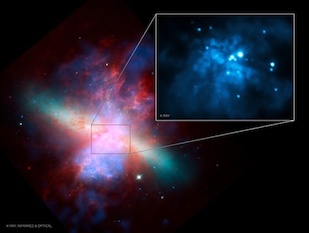NATURE:A 400-solar-mass black hole in the galaxy M82U of Maryland
Fascinating rhythm: light pulses illuminate a rare black hole
The universe has so many black holes that it’s impossible to count them all. There may be 100 million of these intriguing astral objects in our galaxy alone. Nearly all black holes fall into one of two classes: big, and colossal. Astronomers know that black holes ranging from about 10 times to 100 times the mass of our sun are the remnants of dying stars, and that supermassive black holes, more than a million times the mass of the sun, inhabit the centers of most galaxies.
But scattered across the universe like oases in a desert are a few apparent black holes of a more mysterious type. Ranging from a hundred times to a few hundred thousand times the sun’s mass, these intermediate-mass black holes are so hard to measure that even their existence is sometimes disputed. Little is known about how they form. And some astronomers question whether they behave like other black holes.
Now a team of astronomers has succeeded in accurately measuring — and thus confirming the existence of — a black hole about 400 times the mass of our sun in a galaxy 12 million light years from Earth. The finding, by University of Maryland astronomy graduate student Dheeraj Pasham and two colleagues, was published online August 17 in the journal Nature.
...
Caption: This image of the galaxy Messier 82 is a composite of data from the Chandra X-Ray Observatory, the Hubble Space Telescope and the Spitzer Space Telescope. The intermediate-mass black hole M82 X-1 is the brightest object in the inset, at approximately 2 o’clock near the galaxy’s center. Credit: NASA/H. Feng et al.
UMaryland: Light pulses illuminate a rare black hole
- MargaritaMc
- Look to the Evenstar
- Posts: 1836
- Joined: Wed Jan 09, 2013 10:14 pm
- Location: 28°16'7"N 16°36'20"W
UMaryland: Light pulses illuminate a rare black hole
"In those rare moments of total quiet with a dark sky, I again feel the awe that struck me as a child. The feeling is utterly overwhelming as my mind races out across the stars. I feel peaceful and serene."
— Dr Debra M. Elmegreen, Fellow of the AAAS
GSFC: RXTE Decodes the Rhythm of an Unusual Black Hole
RXTE Decodes the Rhythm of an Unusual Black Hole
NASA Goddard Space Flight Center | RXTE | 2014 Aug 18
A 400-solar-mass black hole in the galaxy M82 - Dheeraj R. Pasham, Tod E. Strohmayer, Richard F. Mushotzky
NASA Goddard Space Flight Center | RXTE | 2014 Aug 18
Astronomers have uncovered rhythmic pulsations from a rare type of black hole 12 million light-years away by sifting through archival data from NASA's Rossi X-ray Timing Explorer (RXTE) satellite.Click to play embedded YouTube video.
The signals have helped astronomers identify an unusual midsize black hole called M82 X-1, which is the brightest X-ray source in a galaxy known as Messier 82. Most black holes formed by dying stars are modestly-sized, measuring up to around 25 times the mass of our sun. And most large galaxies harbor monster, or supermassive, black holes that contain tens of thousands of times more mass.
“Between the two extremes of stellar and supermassive black holes, it's a real desert, with only about half a dozen objects whose inferred masses place them in the middle ground," said Tod Strohmayer, an astrophysicist at NASA's Goddard Space Flight Center in Greenbelt, Maryland.
Astronomers from Goddard and the University of Maryland, College Park (UMCP) have suspected M82 X-1 of being midsize for at least a decade, but compelling evidence excluding it from being a stellar black hole proved elusive. ...
A 400-solar-mass black hole in the galaxy M82 - Dheeraj R. Pasham, Tod E. Strohmayer, Richard F. Mushotzky
- Nature (online 17 Aug 2014) DOI: 10.1038/nature13710
Know the quiet place within your heart and touch the rainbow of possibility; be
alive to the gentle breeze of communication, and please stop being such a jerk. — Garrison Keillor
alive to the gentle breeze of communication, and please stop being such a jerk. — Garrison Keillor
